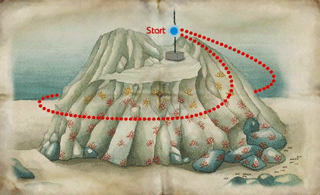Liguria

Secca dell'Isuela
Difficoltà : Immersione difficile in Corrente
L’immersione alla Secca dell'Isuela rimane impressa nella memoria di tutti coloro che la visitano e a pieno titolo viene considerata una delle più belle immersioni del Mediterraneo. Il percorso seguito più frequentemente è nel versante sud-ovest. Si scende lungo la catenaria posizionata sul cappello della secca che arriva ad una profondità minima di 14 mt.
Arrivati sul fondo si nuota verso levante percorrendo un tratto dell'ampio cappello al quale verrà dedicato più tempo in chiusura immersione, al ritorno. Già qui è facile incontrare cernie, banchi di saraghi fasciati, e i dentici che compaiono all’improvviso per poi reimmergersi nel blu. Il pianoro del cappello rapidamente diventa parete. Da questo momento la direzione punta verso la parte più esterna della secca uella rivolta verso il largo.
Il paesaggio è mozzafiato con una grande distesa di gorgonie rosse (Paramuricea Clavata) che mosse dalla corrente (spesso forte) a partire da ca. 25 mt fino a una profondità di 55 mt e più.
La quota massima è di 35 / 38 mt per non ritrovarsi velocemente fuori dalla curva di sicurezza. La parete è molto lunga e si percorre in direzione di ponente. Nelle spaccature delle rocce si incontrano gorgonie ,ma anche grandi rami fioriti di corallo rosso (Corallium Rubrum). Verso il termine della parete sud dell'Isuela, a una profondità di ca. 28 mt, si apre un tetto di roccia coperto a un tappeto di margherite di mare (Parazoanthus) e di Madreporari solitari.
Sul fondo di questo tetto stazionano alcune mustelle di proporzioni ragguardevoli. Da qui la secca fa una svolta decisa di 90° e ci si ritrova nella parete ovest. Da uesto momento inizia la risalita. Si rivedono le gorgonie rosse (Paramuricea Clavata) che lasciano il posto alle gorgonie gialle (Eunicella Cavolini) e riappaiono dal blu numerosi i dentici ben riconoscibili dalla sagoma. Seguendo il lato ponente, si raggiunge il cappello meritevole della visita più approfondita che era stata rimandata all’inizio: l'impressione è di trovarsi immersi in un acquario grazie alla presenza costante di murene, gronghi, polpi, cernie, saraghi e di nuovo, dentici. Massima attenzione al manometro per non perdere il controllo dell’aria in bombola,perché qui le distrazioni sono molteplici e continue, ma la sicurezza viene prima di tutto.
Meglio “sdoppiare” l’immersione che esporsi a rischi.
Si consiglia la risalita sulla catenaria senza abbandonarla per la presenza frequente di forte corrente che potrebbe allontanare dalla barca costringendo a nuotate impreviste in superficie.
 ISUELA
ISUELA
Justly considered one the most beautiful dives in the Mediterranean, Isuela leaves a deep impression in the memories of all who visit it.
The most common route lies along the southwest slope.
We descend along the chain positioned on the head of the shoal, arriving at a minimum depth of 14 meters. Once on the bottom, we head east following a section of the ample shoal head, but without spending too much time here (we'll do this on the way back).
Already here it is common to encounter groupers, swarms of two-banded dassies, and above all, the unmistakable sea breams that appear suddenly out of the blue, only to disappear again. The shoal's plateau quickly turns into a wall. At this point we turn toward the outer part of the shoal, facing out to the deep sea.
This breathtaking scene hosts a large expanse of red gorgonians (Paramuricea Clavata) that sway in the current (which is often strong), beginning from approximately 25 meters and reaching down to 55 meters and beyond. It's a good idea to maintain a maximum depth of 35/38 meters to avoid exiting the safety curve too quickly.
The wall is very long, and we follow it toward the west.
Other than the gorgonians in the various cuts in the rock, we can also see great flowering branches of red coral (Corallium rubrum).
Toward the end of the Isuela's south wall, at a depth of approximately 28 meters, we find a spectacular hanging wall covered with yellow cluster anemones (Parazoanthus) and lone madreporarians. The rear of this wall hosts a few surprisingly large forkbeards.
At this point the shoal makes a decided 90° turn, and we find ourselves on the west side.
It's time to head back up. The red gorgonians (Paramuricea Clavata) give way to yellow gorgonians (Eunicella Cavolini), and numerous sea breams, with their unmistakable shape, begin to reappear.
Following the west side, we reascend toward the plateau, which definitely merits closer inspection.
The impression here is of being in an aquarium, with the constant presence of moray eels, conger eels, octopuses, groupers, dassies, and the inevitable sea breams. Don't forget to check your gauges, because it's easy to get distracted and... end up without any air.
It's hard to leave the seabed, but unfortunately we have to.
We ascend along the chain, because occasionally there is a current and at these times, without the assistance of an ascent line, we could easily end up a good distance from the boat
